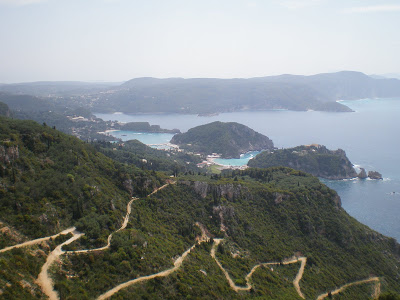after the northwestern village of Krini, stands like a lonesome eagle, a monument which is one among the most important castles in Greece and of Adriatic sea:
Angelokastro. It's not so famous like the two castles of Corfu Town but its military importance in defending the southern end of the Adriatic sea was fundamental. It is one of the three castles that still survive in our island.
A plan of Angelocastro, taken from an old venetian lithograph
It was built in the 12th century by the byzantine despot of the
Despotate of Epirus, Michael Angelos Komninos but recent finds indicate that possibly the hill was fortified as early as 5th century A.D. It was built on a hill which is 330 metres tall. The castle perfectly fits to the location. Each time the enemy was seen approaching the shores from the west, the occupants of the castle lit a fire and with by its smoke, warned the watchmen of the Old Fortress in Corfu Town, some 20 kilometres east. It helped to protect Corfu from the greater menace of the 12th century, the
Normans of Sicily. In 1204, it fell to the hands of
Angevins. When Corfu became a venetian possesion it protected the island from the Genoese pirates and from the Turks. In 1403, a Genoese pirate fleet attacked Angelokastro and they burned the neighbouring villages. They sieged the castle many times but they didn't manage to occupy it. In the great Turkish siege of 1571, Angelokastro stood firm, thus the turkish army didn't succeed in creating a beachhead in the northwestern coast of Corfu (like what they already had done in the eastern one). Finally the turks, after several attempts to occupy the castle and Corfu town withdrew.
Modern plan of the castle - click on the image to zoom
The site is open every day from 8 am to 3 pm. There is a 3 euro ticket to be paid at the entrance downhill.
Below, there is a little photographic tour I did last April.
- Angelokastro from the road which lead to its entrace
-The steps up to the castle's top.
-The walls. This part, suprisingly, is in good condition.
-The main entrance to the top
-We are up to the top now. Ruins all over the place and lots of green!
-Some information about the castle's history. Click to zoom.
-The breathtaking view towards Paleokastritsa from the top.
-A chapel in the rock, dedicated to St. Kyriaki. It was created by digging in the rock and it served as a hermitage as well. The paintings date back to the 18th century.
-View towards the entrance. Notice the blossomed nature all around the place.
-Steps leading to the higher level of the acropolis.
-The ruined walls of the eastern side
-The church of the Acropolis, dedicated to the Archangel Michael and it was built on the site of an older three-aisled church.
- The sea and the rocks of the western side

-One of the three underground cisterns which supplied water to the castle occupants.
-The main gate. It points to the north and it is supported by nearby battlements.
- The stairs down to the entrance.
- Angelokastro from the bottom of the stairs.




























1 comment:
We visited the castle yesterday (Oct 31, 2010), a beautiful, sunny fall day expecting to see wonderful views. There was a sign at the entrance saying that it would be closed beginning Oct.31....no indication of when it would reopen, or even the normal hours or entrance fee. This is information that most foreign visitors expect to find at public monuments. Any ideas for changing that?
from Theda, now a Corfu resident
Post a Comment